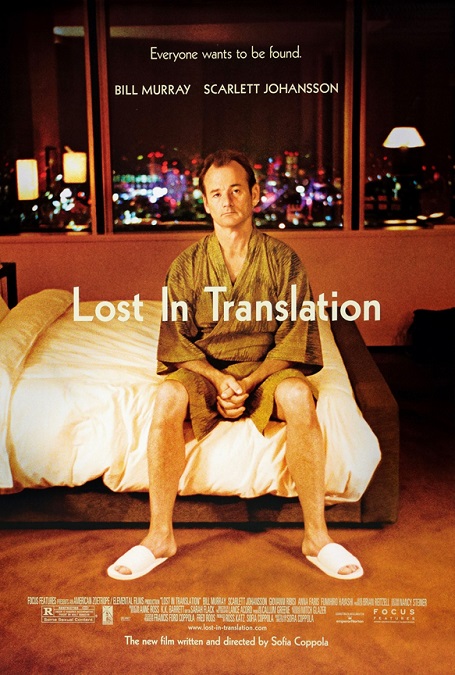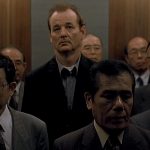
Lost in Translation – 2003
Have you ever wanted to get away from a life that isn’t the one that you want? Have you ever felt depressed and lonely, in need of companionship? I think we all have. In fact, it sometimes seems like we are a generation of people who are going through some kind of social mid-life crisis. We are all out of sync with ourselves, with our environments, and with each other. Lost in Translation seems to embody all these things. It is the story of two lonely people, one young, one old, who seem to be at a crossroad in their lives until they find each other.
Bill Murray played Bob Harris, an actor who has reached a mid-life crisis. He is in Tokyo, Japan, filming a commercial for Suntory Whiskey. Scarlet Johansson arrisH
played Charlotte, a woman who is disillusioned with a marriage in which she seems to find no happiness. She is married to a celebrity photographer named John, played by Giovanni Ribisi, who is in Tokyo on assignment. Neither Bob nor Charlotte want to be where they are. Bob is going through a mid-life crisis and his marriage is showing obvious signs of weakness. Charlotte fels neglected as her husband is constantly working. She is bored and desperately needs companionship.
The two meet and they become fast friends. There is a definite sexual tension between them, yet they both resist the urge to jump into bed. It was a wonderful way to tell their story. Too often, in modern film, romantic leads jump straight into bed without considering the consequences. Lost in Translation is a story about the special kind of relationship that develops when that impulsive urge is resisted. The two leads find comfort in each other as they try to stave off depression.
The title of the movie can be applied to the film in a number of different ways. First, there is the obvious. Neither Bob nor Charlotte spoke Japanese, and so there was an inherent language barrier. There was a scene in which Bob was filming his commercial and the director was giving him a ton of direction in Japanese, but the translator would give him a short instruction. Wikipedia provided the translation which was interesting enough to include here. The director said, “Mr. Bob. You are sitting quietly in your study. And then there is a bottle of Suntory whisky on top of the table. You understand, right? With wholehearted feeling, slowly, look at the camera, tenderly, and as if you are meeting old friends, say the words. As if you are Bogie in Casablanca, saying, ‘Here’s looking at you, kid,’ – Suntory time!” The translator tells him, “He wants you to turn, look in camera. OK?”
But there are also the more subtle failures for Bob and Charlotte as they try to communicate with each other, often not being able to say what they really mean. Does that mean I wanted them to overcome that hurdle and jump into bed? No. I liked that they didn’t. The tension took its time building, and the ending was perfect. They finally realized how much their companionship had meant to each other. After an awkward and forced goodbye, Bob had the chance to do it properly. He chased after her and gave her a properly affectionate embrace, whispered something in her ear that the audience never got to hear, but which made her smile, and gave her a lovely parting kiss. I spent the entire film wanting them to find a deeper connection with each other, and in the end, I felt that they had, all the while refraining from ruining it with sex.
Aside from that, the movie is also an interesting observation of the Japanese culture, a foreign culture that is often one of the strangest to our uneducated, western perspectives. However, many Japanese critics took a certain amount of offense at the way the Japanese characters were portrayed in the film. They said that they were mostly shown without dignity, little Japanese stereotypes, clowns to be laughed at.
But I have to wonder at this. Were we only shown a few examples of a small fraction of their culture and people? Yes. But do those kinds of eccentric or silly caricatures of people really exist in Tokyo? Most definitely. Are those subsets of people really a part of Japanese culture and society? Absolutely, yes. It is significant to note that the film’s director, Sophia Coppola, wrote the screenplay based on her own experiences in Japan, not on the Japanese culture as a whole, with which she may not have had experience. If anything, the one character I really looked down on was John’s actress friend, Kelly, played by Anna Faris, who seemed to be a better match for him than his wife, Charlotte. Also, I never once laughed at any of the Japanese characters in the film.
In fact, I didn’t laugh at anything in the film. The film is listed as a romantic comedy, but I found it to be neither romantic nor funny. There was virtually no comedy in the movie, and the little humor that was there was blunted with a poignant melancholy. Not only that, but the whole thing was filmed in a very disjointed style, almost like a documentary, with a lot of hand-held camera work and abrupt jump cuts that moved the scenes along in a very stiff and hesitant way. It was slow, dramatic, and bordering on depressing. Still, I’ll give it credit for being a better movie than I remember it being when I first saw it in 2003.








